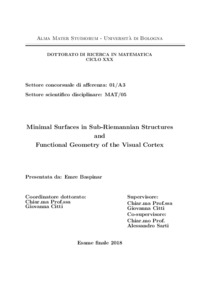Baspinar, Emre
(2018)
Minimal Surfaces in Sub-Riemannian Structures and Functional Geometry of the Visual Cortex, [Dissertation thesis], Alma Mater Studiorum Università di Bologna.
Dottorato di ricerca in
Matematica, 30 Ciclo. DOI 10.6092/unibo/amsdottorato/8661.
Documenti full-text disponibili:
![thesis_baspinar_for_submission.pdf [thumbnail of thesis_baspinar_for_submission.pdf]](https://amsdottorato.unibo.it/8661/7.hassmallThumbnailVersion/thesis_baspinar_for_submission.pdf)  Anteprima |
Documento PDF (English)
- Richiede un lettore di PDF come Xpdf o Adobe Acrobat Reader
Disponibile con Licenza: Salvo eventuali più ampie autorizzazioni dell'autore, la tesi può essere liberamente consultata e può essere effettuato il salvataggio e la stampa di una copia per fini strettamente personali di studio, di ricerca e di insegnamento, con espresso divieto di qualunque utilizzo direttamente o indirettamente commerciale. Ogni altro diritto sul materiale è riservato.
Download (7MB)
| Anteprima
|
Abstract
We develop geometrical models of vision consistent with the characteristics of the visual cortex and study geometric flows in the relevant model geometries. We provide a novel sub-Riemannian model of the primary visual cortex, which models orientation-frequency selective phase shifted cortex cell behavior and the associated horizontal connectivity. We develop an image enhancement algorithm using sub-Riemannian diffusion
and Laplace-Beltrami flow in the model framework. We provide two geometric models for multi-scale orientation map and orientation-frequency preference map construction which employ Bargmann transform in high dimensional cortical spaces. We prove the uniqueness of the solution to sub-Riemannian mean curvature flow equation in the Heisenberg group geometry. An iterative diffusion process followed by a maximum selection mechanism was proposed by Citti and Sarti in the sub-Riemannian setting of the roto-translation group. They conjectured that this two-fold procedure is equivalent to a mean curvature flow. However a complete proof was missing, even in the Euclidean setting. We prove in the Euclidean
setting that this two fold procedure is equivalent to mean curvature flow.
Abstract
We develop geometrical models of vision consistent with the characteristics of the visual cortex and study geometric flows in the relevant model geometries. We provide a novel sub-Riemannian model of the primary visual cortex, which models orientation-frequency selective phase shifted cortex cell behavior and the associated horizontal connectivity. We develop an image enhancement algorithm using sub-Riemannian diffusion
and Laplace-Beltrami flow in the model framework. We provide two geometric models for multi-scale orientation map and orientation-frequency preference map construction which employ Bargmann transform in high dimensional cortical spaces. We prove the uniqueness of the solution to sub-Riemannian mean curvature flow equation in the Heisenberg group geometry. An iterative diffusion process followed by a maximum selection mechanism was proposed by Citti and Sarti in the sub-Riemannian setting of the roto-translation group. They conjectured that this two-fold procedure is equivalent to a mean curvature flow. However a complete proof was missing, even in the Euclidean setting. We prove in the Euclidean
setting that this two fold procedure is equivalent to mean curvature flow.
Tipologia del documento
Tesi di dottorato
Autore
Baspinar, Emre
Supervisore
Co-supervisore
Dottorato di ricerca
Ciclo
30
Coordinatore
Settore disciplinare
Settore concorsuale
Parole chiave
Visual cortex, uniqueness, mean curvature, sub-Riemannian geometry, Laplace-Beltrami, diffusion, orientation map, frequency map
URN:NBN
DOI
10.6092/unibo/amsdottorato/8661
Data di discussione
14 Maggio 2018
URI
Altri metadati
Tipologia del documento
Tesi di dottorato
Autore
Baspinar, Emre
Supervisore
Co-supervisore
Dottorato di ricerca
Ciclo
30
Coordinatore
Settore disciplinare
Settore concorsuale
Parole chiave
Visual cortex, uniqueness, mean curvature, sub-Riemannian geometry, Laplace-Beltrami, diffusion, orientation map, frequency map
URN:NBN
DOI
10.6092/unibo/amsdottorato/8661
Data di discussione
14 Maggio 2018
URI
Statistica sui download
Gestione del documento:


 Login
Login
